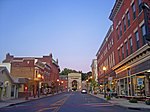Delaney Hotel

The Delaney Hotel, also the North Hoosick Hotel and Hathaway Hotel, is located at the junction of NY 22 and 67 in the hamlet of Hoosick, New York, United States. It is a large Greek Revival-style building dating to the middle of the 19th century with some later Italianate decoration. Few alterations have been made, and it is a well-preserved example of vernacular interpretations of those styles in a rural building. It was a stagecoach and railroad stop in its peak years. Later owners continued to operate it as a hotel, despite declining business, into the middle of the 20th century. After a period of vacancy and decline, it was listed on the National Register of Historic Places in 1995. In the 1980s it was nearly demolished. Recently a new set of owners has proposed to turn it into a bed and breakfast.
Excerpt from the Wikipedia article Delaney Hotel (License: CC BY-SA 3.0, Authors, Images).Delaney Hotel
NY 67,
Geographical coordinates (GPS) Address Nearby Places Show on map
Geographical coordinates (GPS)
| Latitude | Longitude |
|---|---|
| N 42.928333333333 ° | E -73.3425 ° |
Address
NY 67 22198
12090
New York, United States
Open on Google Maps






